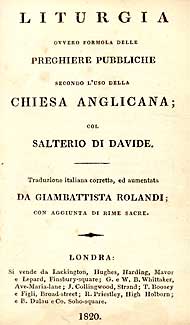CHAPTER XII
ITALIAN TRANSLATIONS
WILLIAM. BEDELL, Bishop of Kilmore and Ardagh, was born in 1571 and died in 1642. In 1588 he graduated B.A., and in 1592 commenced M.A., from Emmanuel College at Cambridge. He was ordained priest in 1597, and two years later he proceeded B.D. His aptitude as a linguist led his Italian friends in Venice to request him to compile an English grammar for them. In 1607 he was invited to fill the place of chaplain to Sir Henry Wotton, the British ambassador to the Venetian Republic. After a stay in Italy extending about three years and a half, he returned to England and resided at Bury St. Edmund’s in Suffolk, where he had lived before going to Italy. In 1629 he was consecrated to the united bishoprics of Kilmore and Ardagh. Owing to his strong objection to pluralities he resigned the see of Ardagh in 1633. While bishop he appointed as new incumbents invariably those candidates who possessed some knowledge of the Irish language. Undaunted by the unpopularity among the ruling authorities, brought upon him by his conscientious actions and justice, he continued to employ his best efforts for the people. The churches were repaired and made available for public worship, and the translation of the Scriptures into the Irish vernacular was completed by the addition of the Old Testament carried out under his personal supervision.
Bedell's accurate knowledge of Italian, coupled with his oft-expressed
desire to win over the people of Venice to Protestantism must have led
him to begin a translation of the liturgy of his church into Italian.
But more than forty years passed since his death, in 1642, before the
first translation of the Prayer Book into Italian was published. It was
edited by Edward Browne, of Clare Hall, Cambridge, who signs the preface,
dated 1685, with “Edvardo Brown Presbitero della chiesa Anglicana.” The
title of this editio princeps reads: Il Libro | delle Preghiere
Publiche | ed | Amministrazione de sacramenti, | ed | altri riti e Ceremonie
della Chiesa | secondo l’Uso della | Chiesa Anglicana; | insieme
col | Saltero over | Salmi | di | David | Come hanno da esser recitati
nelle | Chiese. | E la forma e modo di Fare, Ordinare e Consacrare |
Vescovi, Presbiteri e Diaconi. | Londra: | Appresso Moise Pitt. MDCLXXXV.
(72), 550, 24 pages. Page, 2¾ x 5; paper, 3¾ x 6 inches[1].
Griffiths 66:2
According to some authorities the translation was the work of Browne himself, assisted by Giovanni Battista Capello. This latter is probably the more correct view as to the authorship of this first Italian translation. As far as can be ascertained from existing biographies of Bedell, or from contemporaneous writers, he left no manuscript translation. Nor is there in any of these biographies direct reference made to his having either begun or completed such a task. That he had the desire and intention of doing so there can be no doubt. That he probably translated some portions or Offices of the Liturgy we may well assume. But the fact that more than forty years intervened before the first Italian translation appeared, speaks very much against Bedell as its main translator. He certainly did not translate the Ordinal of 1662, etc. On the whole, therefore, it seems more probable that Browne was the translator of the greater portion, if not of the whole Liturgy, using perhaps some manuscript notes of the late bishop.
A revised edition appeared in 1733, entitled: Il libro | Delle Preghiere Publiche | ed | Administrazione de’ Sacramenti, | ed | Altri Riti e Cerimonie delIa Chiesa, | Secondo ruso della | Chiesa Anglicana; | Insieme col | Saltero over i Salmi | Di | David, | Come hanno da esser recitati nelle | Chiese. | E la forma e modo di fare, | ordinare e consacrare | Vescovi, Presbiteri e Diaconi: | Questa nuova Impressione revista e corretta per | Alessandro Gordon, A.M. | Londra: Per Alessandro Blackwell, e si | vende da Gio. Wilcox ... 1733.
Title, reverse blank, sig. A — Z, Aa — Zz, Aaa — Ccc 5, in sixes.
Page, 3⅛ x 5½; paper, 3⅝ x 6⅛ inches.
[1) A copy of the 1685 translation is in the J. P. Morgan Library, and another in the library of the General Theological Seminary, New York, N.Y.
Griffiths indicates that Bedell made an earlier translation, apparently now lost. Another manuscript translation was made by Alexander Amadei in Florence in 1661. (Griffiths 66:1)
The reviser is, probably, identical with Alexander Gordon, the antiquary (1692?-1754?) whose travels in Italy secured for him, undoubtedly, a good working knowledge of Italian.
An entirely new translation was published in 1796. It reads :
* La Liturgia, | ovvero formola delle | Preghiere publiche | secondo l‘Uso della | Chiesa Anglicana, , col | Satterio [sic] di Davide. | Nuovamente tradotta dall’ Inglese nel Tosco Idioma | da A. Montucci e e L. Valetti, | professori di lingua Italiana. | Londra: | Si vende appresso di Vernor ed Hood . . . 1796.
Without pagination. Page, 2¼ x 4; paper, 3 x 4¾ inches. Title, reverse
blank. Sig. A (prefatory matter), B — X in twelves; Y 8 leaves. This
translation omits all the Occasional Offices except the farm far Matrimony
and far the Churching of Women. It omits, likewise, the special farms
of State Services and the Articles of Religion. The translation is also
contained in the Bagster edition of The Book of Common Prayer, . . .
in eight languages, . . . 1821; revised, however, “sotto la direzione
e cura del Sig. Andrea Calbo”. Antonio Montucci (1762-1829) was known
in later years as a prominent Chinese scholar.
Bagster version is Griffiths 66:6 and 66:7
[2) See, especially, Burney, Memoirs of the Life and Writings of the Abate Metastasio. 3 vols. London, 1796.
Griffiths 66:9 (1841); 66:10 (1849). Griffiths indicates that these were revisions, not reprints
Griffiths 66:11
(1850); 66:12
(1862 and reprinted through 1928)
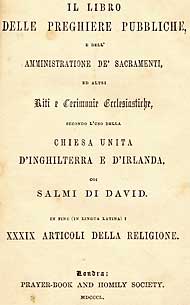 Griffiths 66:11 (1850 printing) |
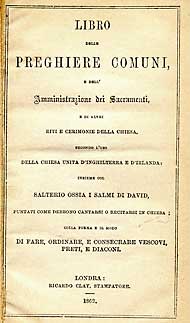 Griffiths 66:12 (1862 printing) |
“In 1903 appeared at Milan the Liturgia af the ‘Chiesa Cattolica Riformata d’Italia.’ Liturgically it is a combination of the Book of Common Prayer and the Roman books ; though the Calendar is entirely Anglican, a good deal of Roman matter remains in the framework of the Offices.” — P.B.D., p. 555, col. 2.
In 1874 appeared L’Ordine | del | servizio divino | per la mattina e per la sera, | e | dell ’Amministraziane dei Sacramenti, | estratta dal | Libra delle Preghiere pubbliche | della | Chiesa Episcapale; | can Salmi ed inni, | par le | Missiani italiane. | Società per la | promotione delle Verità evangeliche .... New York. 120. pages, 24mo.
This translation was made by Dr. Constantine Stauder, formerly a Roman Catholic priest, who. had refused in 1870 to submit to the decrees of the Vatican Council, and had became a member of the Protestant Episcopal Church through the agency of the Rev. Dr. Siegmund. On his father’s side Stauder was a German. In New Yark he conducted Italian services in Grace Chapel. He left New York between 1886 and 1889 and returned to Europe.
In 1874 Stauder urged in the General Convention that the entire Prayer Book of the Church be translated into Italian. Accordingly, a Commission and Joint Committee was apppointed by the Convention, in the persons of the bishop of Central New York, the assistant bishop of North Carolina, the Rev. R. J. Nevin, D.D., the Rev. C. Stauder and F. P. Nash, Esq. It was shortly after this commission was appointed that Stauder published the mission book mentioned, for the use of the missions of the Church among the Italians. In 1880 he presented to the General Convention a manuscript of the Book of Common Prayer translated into Italian. The translation was not printed. The committee to whom the board of the New York Bible and Prayer Book Society had referred, in 1881, Stauder’s manuscript and petition to print, had placed it in the hands of an eminent Italian scholar for examination, who returned in writing a most thorough and scholarly criticism. This criticism was very unfavourable, and in the opinion of the committee precluded any further efforts being made by the· Society towards securing its publication.
”In addition to this adverse report the Committee
would state that upon an examination of the wording of the resolutions
adopted by the last General Convention the authority to publish was
confined to translation prepared by Mr. F. P. Nash, of Baltimore”[3].
Griffiths 66:14
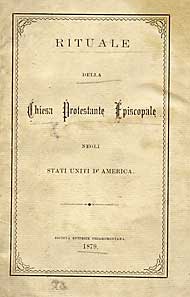
Italian translation of portions of the US BCP, 1879 (not listed here or by
Griffiths)
In 1886 the bishop of Central New York, from the Joint Committee on the Translation of the Book of Common Prayer into the Italian language, presented their report [to the General Convention], submitting a copy of the Book of Common Prayer translated into the Italian language, together with a prefatory note thereto submitted by the translator, Professor Francis Philip Nash, of Hobart College, New York.
“On motion of the Bishop of Albany, the Committee
was authorized to take steps for the publication of the proposed book
without expense to themselves or the General Convention”[4].
Nash’s translation appeared the same year, 1886. The translator was born in Florence, Italy, December 5, 1836, and died in Boston, February 5, 1911. A brief obituary, published in the Harvard Graduate Magazine, March, 1911, p. 494, co!. 1, states that:
“He also published, anonymously, a translation
of the Prayer Book of the American Episcopal Church into Italian.”
[4] Journal of the Proceedings of General Convention, 1886, p. 103. See ibid., pp. 796, 797; also, 1874, p. 216; 1880, pp. 151, 189; 1883, p. 321.
Nash's translation is not listed by Griffiths.
A translation of the whole Prayer Book was also made by the Rev. M. Zara, entitled, *Libro | delle preghiere comuni | e | dell’ Amministrazione dei Sacramenti | e di altri Riti e Cerimonie | secondo l’uso della | chiesa Protestante Episcopale | degli Stati Uniti d’America. | Con | il Salterio o Salmi di Davide. | Printed for | Bishop White Prayer Book Society. | Philadelphia. [1904.] (1), xxviii, 566 pages. 24mo. Printed in long lines.
The Rev. Michele Zara was born at Leece, Italy, May 13, 1844. He was ordained priest in the Roman Catholic Church, April 7, 1867. After fifteen years of faithful service, he left the Church of Rome and joined the Protestant Episcopal Church in the United States. He then started one of the most successful missions among the Italians of Philadelphia. In 1903 he was commissioned by the Bishop White Prayer Book Society to make a new translation of the Prayer Book, a task Mr. Zara completed in about a year and a half. It was published in 1904, as stated above[5].
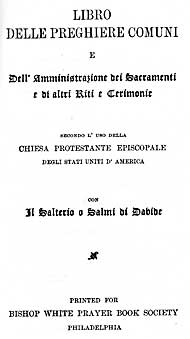
[5] The biographical data were kindly communicated to the author by Mr. Zara in a letter of January 11, 1912.
CHAPTER XIII
PORTUGUESE TRANSLATIONS
THE first translation of the Liturgy into
Portuguese was published in 1695. Its title reads: O Livro da Oraçaõ Commum,
e Administraçaõ dos
Sacramentos, e outros Ritos, & Ceremonias da Igreja, conforme o Uso
da Igreja de Inglaterra; juntamente corn o Salterio ou Salmos de David.
Oxford: Na Estampa do Teatro. Anno de Christo 1695. Fol. Paper, 8-15/16
x 14 inches.
The edition contains a Prayer for the East India Commpany. The Psalter differs materially from the translation of João Ferreira de Almeida († 1691) and others. The translation was the work of Benjamin Woodroffe and Isaac Abendana.
The book was intended, apparently, for use in Portuguese-speaking congregations in communion with the Church of England in the East Indies. It includes the first edition of the Psalter in Portuguese. While closely following the English Prayer Book, this Portuguese translation is not an exact reproduction of it, e.g. it omits much of the preliminary matter, and the Articles. It contains some portions of the preliminary matter; tables and calendar; the Order for Morning and Evening Prayer, etc.; the Collects, Epistles and Gospels; various Offices from Prayers for use at Sea, etc., down to the Commination Service; the Psalter (with a separate title); and the Form of Prayer for the Fifth of November, ending on sig. Dd 1. The statement by Darlow and Moule, Vol. II, Part iv, page 1233: “G. L. Santos Ferreira records a second edition of this Prayer Book, issued by W. Bowyer, at London, 1715, 8vo,” is probably erroneous. The edition published by Bowyer in 1715 was the second of the Spanish translation by Alvarado.
Woodroffe (1638-1711), matriculated in Christ Church, Oxford, in 1656, graduated B.A. in 1659, M.A. in 1662, and was incorporated at Cambridge in 1664. In 1674 he was appointed chaplain to Charles II. He proceeded B.D. and D.D. in January, 1672/3, and was admitted as principal of Gloucester Hall in 1692. He died in London, August 14, 1711. Woodroffe was a learned man, knowing a number of languages, including Italian, Portuguese and “some of the Orientals. “
Isaac Abendana was a teacher of Hebrew at Oxford University. He was
born about the middle of the seventeenth century, and died about 1710.
He lived during his earlier years in Hamburg and in Leyden, where also
he studied medicine. He came to England and soon became professor of
Hebrew at Oxford. Previous to this he had been at Cambridge, where it
appears from the books of the senior bursar of Trinity College, “that
one Abendana the Jew received from the college £2 per
annum during
the years 1664-1666.” He apparently left Cambridge for Oxford in
1671. There he stood in high favour with the president of Hertford College,
to whom he dedicated the Jewish calendars published in 1695, 1696 and
later[1]. He wrote a comprehensive work, entitled, Discourses
of the Ecclesiastical and Civil Polity of the Jews, etc., London, 1706,
8vo, of which a second edition appeared in 1709. The work is an elaboration
of the essays already commenced in the calendars. Isaac’s brother
was Jacob Abendana (1630-95), rabbi of the flourishing Portuguese synagogue
at London from 1679 until his death. Jacob was a great scholar. About
the year 1660 the two brothers published at Amsterdam the Bible Commentary
Miklal Yofi of Solomon ben Melek, together with Jacob’s own additions,
known as Leket Shikhah, i.e. “Gleanings.” While the brothers
were Spanish Jews by birth, they both spoke and wrote Portuguese with
great ease and fluency[2].
In 1611 the East India Company had established factories at Madras (originally Fort St. George). Thirty years later they founded a settlement at Hooghly, which in 1698 was removed to Calcutta, then an insignificant village. In 1662 the Portuguese gave the town and island of Bombay as part of the dowry of Katharine, the wife of Charles II, by whom it was made over to the East India Company. The evil results arising from the fact that many Portuguese Roman Catholic women preferred living with the men of their choice without marriage, and so retain control of their children’s religion, brought on foot a scheme for the conversion of the Portuguese in the Indian territory, then in the hands of the East India Company. These as well as the slaves who also understood Portuguese were to be preached to in the Portuguese language according to the Protestant doctrine and prayers of the Church of England. Accordingly, the work of translating the Liturgy was done by Abendana, whom Woodroffe engaged at the advice, perhaps, of the Rev. Jethro Brideoake, one of the two chaplains going out to India in 1695. In a letter, January 31, 1695/6, the directors of the Company wrote to the Fort St. George Council:
"We have caused the Liturgy of the Church of England with the Psalms of David to be translated into the Portuguese language for the use and benefit of the Portuguese inhabitants under our Government in India, which we printed at Oxford; and herewith you will receive one hundred of them, which we hope, our Lieutenant General and Council will give such direction to Mr. Lewes that they may be ’made use of to answer that general and extensive charity which first moved us to this undertaking at our single charge .... “
The intention of the promoters of the scheme and of the directors was beyond praise. But the scheme itself was not sufficiently considered before being carried out. The Portuguese lingua franca of the European settlements in India was a patois combination of several languages, of which Portuguese formed the foundation and the framework. It would have been just as easy to teach the Eurasians and natives, who spoke this patois, English as to teach them the Portuguese as contained in the translation of 1695. The Rev. George Lewes had studied Portuguese and soon became proficient in the patois. He was sent out especially to minister to the Portuguese Eurasians in their own tongue, and continued to do so until he resigned’ the service in 1714. But when he was gone the effort was not continued by his successors. They gave their attention to education in English; and gradually the Portuguese patois dropped out of use. This was evidently contrary to the clause contained in the charter granted to the Second East India Company in 1698, which stipulated that:
“All such ministers as shall be sent to reside
in India, as aforesaid, shall be obliged to learn, within one year
after their arrival, the Portuguese language and shall apply themselves
to learn the native language of the country where they shall reside,
the better to enable them to instruct the Gentoos that shall be the
servants or slaves of the same Company, or of their agents, in the
Protestant religion”[3].
Small wonder, then, that almost a century elapsed before another edition of the Portuguese translation was published in 1783, at Calcutta — Na Offiçina da Missao Ingleza, 8vo. It does not contain the Psalter. A reprint of this edition appeared at Vepery in 1800[4].
In 1844, and again in 1849, the S.P.C.K. revised the 1695 edition, introducing many corrections and some additions. The revision is entitled: O Livro de Oraçaõ Commum, Administraçaõ dos Sacramentos, e outros Ritos e Ceremonias da Igreja, segundo o Uso da Igreja unida de Inglaterra e Irlanda: seguese o Salterio, ou Salmos de David, apontados assim como devem ser cantados ou resados nas igrejas; e a forma e modo da ordinaçaõ and consagraçaõ de Bispos, Presbyteros e Diaconos. [Londres]. Na Officina de Guil. Watts, 1844. xxxiv, 447 pages, 8vo.
A further revision was published in 1862; and later editions appeared in 1866, etc.
For editions of the Prayer Book, in whole or in part, for the use of the Lusitanian Church see above, Chapter XI.
Griffiths 137:2
[4] According to Darlow and Moule, Vol. II, Part iv,p. 1,239 “there appeared in 1793 at Calcutta ‘na Officina da Missaõ Ingleza,’ an octavo edition of the Prayer Book [in Portuguese], omitting the Psalter.” They evidently mean the 1783 edition. “A similar edition appeared at Vepery in 1800.”
Griffiths 137:5 (1844, and reprinted in 1848, 1849, 1852, 1862, 1866, 1875, 1886)
The Portuguese were the earliest European settlers in Ceylon, giving way to the Dutch in 1656. The Dutch remained in possession till 1796, when the British, in turn, became rulers of the country by capturing Colombo. The inhabitants of Ceylon, who are now called Portuguese, are descendants of the Portuguese original settlers by native women. They are morally and socially inferior even to the Sinhalese and the Tamulians. Learning is at low ebb among them, and the only books in their language are parts of the Bible and the whole Book of Common Prayer, both of which have been translated for them by the missionaries within the last century.
The Ceylon Portuguese differs from the European Portuguese chiefly in
its having adopted a number of, native Sinhalese and Tamil words. It
is extensively used throughout the country, not only among the descendants
of the Portuguese themselves, but among the Sinhalese in the maritime
provinces and the Dutch. It has become the general household language[5].
It was in 1820 that the Rev. Robert Newstead, of the Wesleyan Missionary
Society, translated portions of the Liturgy of the Church of England
and had it published, entitled: A Fórma da Oraçaõ Publico,
e Administraçaõ dos Sacramentos, conforme a o uso da Igreja
Inglaterra. Traduzido por o missão, em lingua portuguez de Ceylon
.... Em Colombo. Impressado na officina Wesleyano. 1820. 44 pages.

First (1884) BCP of the Lusitanian Church
[5] A most interesting account of this dialect is given by Sebastiao Rodolpho Dalgado in his Dialecto indo-portuguès de Ceylão,’ Lisboa ; Imprensa nacional, Igoo; XXIX, 255, (3) pages. Large 8vo.
Griffiths 138:1
Newstead translated also the New Testament into the Indo-Portuguese. This was printed in 1826. He likewise translated several books of the Old Testament, and a hymnal, which was printed in 1823 (212, (4) pages, 8vo); second edition, the same year (223 pages, 8vo) , and many later editions.
The Psalter, translated by Newstead, was published in , 1821 by the Colombo Auxiliary Bible Society. Its title reads: O Psalterio, ou Psalmos de David, como apontado a ler nas Igrejas . . . Traduzido em lingoa Portugueza de Ceylon, e publicado por a Sociedade Biblia de Colombo. This Psalter is arranged for liturgical use, and really forms an appendix to the portions of the Prayer Book put out in 1820 and mentioned above. 102 pages. 8vo.
An edition of the complete Prayer Book, including the Psalter, translated by Newstead, appeared in 1826, entitled:
* O Livro de | Oraçaõ Commum, | e Administraçaõ de | os Sacramentos, | e outros | Ritos e Ceremonias de a Igreja, | conforme de o | Uso de a Igreja de Inglaterra: | Juntamente com | o Psalterio, | ou | Psalmos de David. | Traducido em Lingoa de Indo-Portugueza. | Londres: | Impressado ne a | officina de G. Ellerton & J. Henderson. | MDCCCXXVI.
(3), 239 pages for the Prayer Book proper. The Psalter is not paged;
it has sig. b-p in fours. Page, 3¼ X 6¼; paper, 5¾ x 9 inches. Printed
in double columns. The Prayer Book has title-page, reverse blank; table
of contents, reverse blank; preliminary matter, 16 pages; text proper,
pp. 17-239; p. 240 blank.
In the fall of 1858 the Rev. John P. Robinson, rector of the Free Church of St. Mary’s for sailors, Boston, Massachusetts, and seaman’s chaplain at the port, sent to the New York Bible and Common Prayer Book Society an application to print an edition of the Book of Common Prayer in the Portuguese language, in preparation by him. The Society stated that it had no authority to print the Book of Common Prayer in any language other than the English without the permission of the General Convention for that purpose[6]. We have seen, in Chapter XI, that the committee of the General Convention accepted a translation made by Dr. Theodore Dwight. This was published in 1860, entitled: O livro | de | Oração Commum, | administração | dos Sacrament os, | e outros | Ritos e Ceremonias da Igreja, | secundo o uso | da Igreja Protestante Episcoopall nos | Estados Unidos d’America; | junto com | o Psalterio, ou Psalmos de David. | MDCCCLX.|| 703 pages. Small 8vo. Long lines.
This translation was often reprinted.
[6] See Lowndes, A Century oj Achievement, Vol. II, p.609.
Griffiths 137:6 (1860, reprinted 1874)
Griffiths 167:7 (1898, reprinted 1914)
The edition was approved by the Bishop of West Virginia[8]. It was used especially for the work in Brazil in charge of Bishop Kinsolving. There were demands also for this version in settlements of Portuguese in the United States, notably in New Bedford, Massachusetts, and in the West[9].
Concerning the story of this translation, Dr. Brown[10] writes as follows:
” The translation was made by me with the aid of the Rev. John Gaw Meem[11], and in grammatical questions of the Rev. Americo Vespuccio Cabral[12]. Soon after coming out to Brazil as a missionary of P. E. Church in the U.S.A. in 1891, I found in use in the churches a little leaflet containing Morning and Evening Prayer, the Litany and a few selected Psalms.
“As soon as I had acquired a fair knowledge of the Portuguese language, I determined to make a complete translation of our Book of Common Prayer. Beginning in 1893, I spent every moment I could spare from my other duties on this translation, and was able to take with me the manuscript of the whole Prayer Book on the occasion of my return to the U.S. in 1897.
“All the tables were prepared by the Rev. John Gaw Meem, who also revised the Collects, to be used throughout the year. The Psalms, Epistles, Collects and other passages of Scripture were taken from the Bible translation of the Rev. João Ferreira d’ Almeida[13].
“The rest of the work was done by me. I had before me the translation into Portuguese of the Prayer Book of the Church of England, and also the translation of the American Prayer Book to which latter I owe much, but just to what extent I was indebted I cannot now say, as I cannot get copies of them for the purpose of comparing.”
[8] See the Reports of the Custodian of the Standard Book in Journal of the Proceedings of General Convention, 1898, p. 533, and 1904, p. 478.
[9] Lowndes, loc. cit., Vol. II, p. 860.
[10] Letter dated Rio de Janeiro, August 31, 1912. Dr, Brown is rector of the Church of the Redeemer, Rio de Janeiro, Brazil.
[11] The Rev. J. G. Meem is rector of the Church of the Redeemer, Pelotas, Brazil, historiographer and president of the Standing Committee of the missionary district of the Protestant Episcopal Church in Brazil.
[12] Cabral is rector of Trinity Church, Porto Alegre, Brazil.
[l3] Almeida was born of Roman Catholic parents in Lisbon in 1628, and at an early age emigrated to Batavia, where he became a Protestant in 1642. He died in 1691 as a minister of a Protestant congregation in Batavia.
